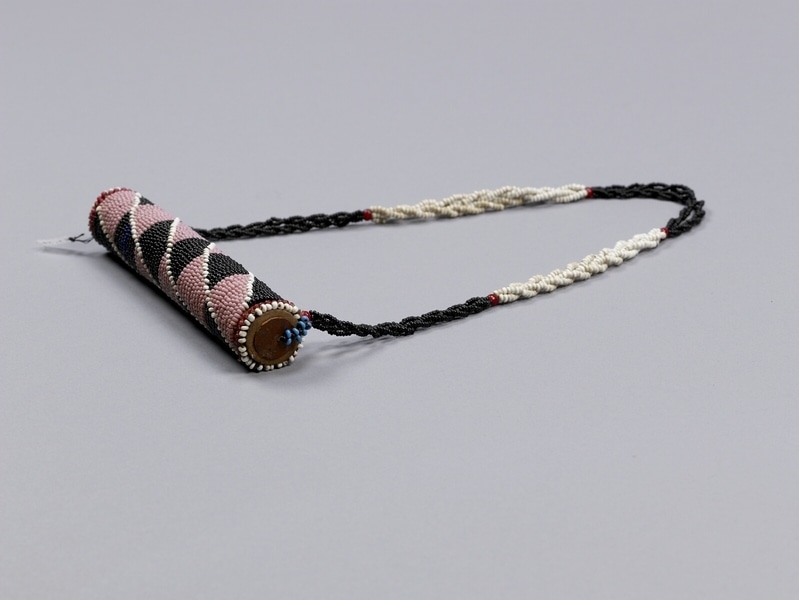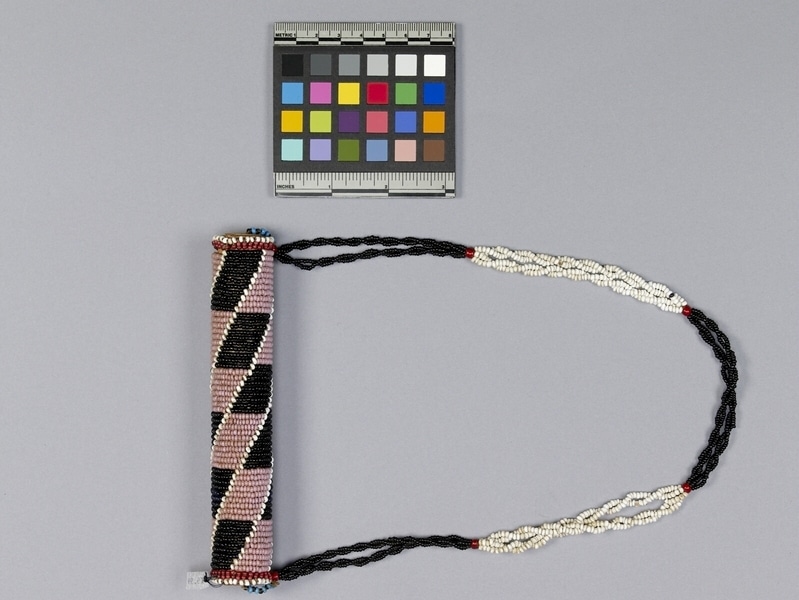Snuff Container Item Number: K5.59 from the MOA: University of British Columbia


Description
Beaded snuff container with twisted black and white beaded strands to form a strap. There are red accent beads in between the sections of colour on the strap. The container portion is covered in beaded sections of black and pink and accented with a single white beaded spiral down the length of the container. Each end is rimed with red and white beads. The strap is attached to gourd plugs found at each end of the container.
History Of Use
Snuff container (ishungu, plural amashungu) worn by men, who receive them as a gift from their fiancee. In the early 20th century beaded items were primarily used for courting Zulu adults, and to display wealth and social standing. To initiate a relationship, women give gifts of beaded items to suitors; the more elaborate and extravagant the beads, the more social currency is ascribed to the accessory. In the case of amashungu, extravagance and pleasure are on full display and denote its wearer as a high-status, wealthy, and culturally-relevant individual. As a symbol of courting status, amashungu are designed to facilitate effective and peaceful socialization between the male suitor and his soon-to-be in-laws.
Narrative
Collected by Captain E. M. Wilmot.
Specific Techniques
Amashungu are made using a beadworking technique called gongqoloza, which involves wrapping a string of already-strung beads around a core.
Item History
- Made in South Africa between 1850 and 1900
- Collected between 1899 and 1902
- Owned by Edmond M. Wilmot
- Owned by Francis H. Wilmot before March 14, 1960
- Received from Francis H. Wilmot (Donor) on March 14, 1960
What
- Name
- Snuff Container
- Identification Number
- K5.59
- Type of Item
- container
- Material
- fibre, glass, bamboo grass and gourd fruit
- Manufacturing Technique
- beaded and strung
- Overall
- height 23.0 cm, width 17.0 cm, depth 3.0 cm
Who
- Culture
- Zulu
- Previous Owner
- Edmond M. Wilmot and Francis H. Wilmot
- Received from
- Francis H. Wilmot (Donor)
Where
- Holding Institution
- MOA: University of British Columbia
- Made in
- South Africa
When
- Creation Date
- between 1850 and 1900
- Collection Date
- between 1899 and 1902
- Ownership Date
- before March 14, 1960
- Acquisition Date
- on March 14, 1960
Other
- Item Classes
- beadwork
- Condition
- good
- Current Location
- Case 102
- Accession Number
- 0019/0018